Table of Contents
Understanding Enriched KPI Metrics
- Definition of Enriched KPI Metrics
- Differences Between Metrics and KPIs: When is a Metric a KPI?
- Examples of Commonly Misunderstood Metrics
Categories of Enriched KPI Metrics
- Operational KPI Metrics
- Financial KPI Metrics
- Customer KPI Metrics
- Employee KPI Metrics
- Risk KPI Metrics
Challenges in Implementing Enriched KPI Metrics
- Metrics Overload
- Resource Constraints
- KPI Prioritization
- System Integration Issues
- Cultural Resistance
- Data Quality and Accuracy
Best Practices for Enriched KPI Metrics Management
- Align Metrics with Strategy
- Limit Focus to Key Metrics
- Promote Transparency
- Ensure Data Integrity
- Regularly Review and Adjust KPI Metrics
- Integrate Advanced Analytics
- Create a Performance Culture
How to Measure Enriched KPI Metrics
How to Interpret and Analyze Enriched KPI Metrics
- How to Analyze and Interpret KPI Metrics
- Understanding Trends and Patterns
- The Role of Advanced Analytics Technology (AI, Predictive Modeling)
Improving Business Performance with Enriched KPI Metrics
- How Enriched Metrics Drive Business Improvements
- How Enriched Metrics Improve Strategic Decision-Making
- How to Create a Performance-Driven Culture
Introduction
Mid-sized companies face increasing pressure to not only measure their performance but to predict and unlock future growth. With competition intensifying and customer expectations constantly evolving, relying solely on traditional metrics is no longer enough. Businesses must look beyond basic data points and embrace enriched KPI metrics to stay ahead.
Enriched KPI metrics are enhanced performance indicators that integrate a broad range of internal and external data sources, offering a more comprehensive view of business performance. By enriching KPIs with data like economic trends, market conditions, or customer behaviors, businesses can move from merely tracking what happened in the past to predicting what will happen in the future, ultimately enabling more informed, forward-looking decision-making.
Enhanced insights go beyond superficial numbers, helping business leaders make smarter, data-driven decisions. For mid-market companies, which often have limited resources compared to larger competitors, adopting enriched KPI metrics can be a powerful tool for driving operational efficiency and ensuring that strategies align with real-time business needs.
By leveraging enriched KPI metrics, companies can:
- Unlock growth potential by identifying hidden opportunities.
- Enhance decision-making with a more complete view of performance.
- Predict future outcomes with greater accuracy, allowing them to adapt faster.
- Align organizational goals with real-world performance metrics.
In essence, enriched KPI metrics empower mid-sized businesses to take a proactive rather than reactive approach to performance management. This guide explores the value of enriched KPIs, how they differ from standard metrics, and how to implement them effectively to fuel growth and predict future success.
Understanding Enriched KPI Metrics
Enriched KPI metrics go beyond standard performance measures by incorporating a wide array of internal and external data sources, providing a more holistic view of business performance. Enhanced KPIs allow organizations to gain deeper insights into their operational, financial, and strategic health, making improving performance outcomes and driving sustainable growth easier.
Definition of Enriched KPI Metrics
At their core, KPIs are quantifiable measures that assess how effectively a business achieves its key objectives. However, enriched KPI metrics take this concept a step further by integrating additional layers of data both quantitative and qualitative from various sources. These could include external factors such as industry benchmarks, market conditions, or customer sentiment, as well as internal organizational data like operational efficiency or employee productivity metrics.
By blending different data points, enriched KPIs offer a more accurate and comprehensive understanding of business performance. They help leaders make smarter, data-driven decisions that align with real-world market dynamics. Enriched KPIs transform traditional metrics into powerful tools for predictive analytics, allowing businesses to anticipate future performance and adjust their strategies accordingly.
Differences Between Metrics and KPIs: When is a Metric a KPI?
It’s important to distinguish between metrics and KPIs, as the terms are often used interchangeably but represent different concepts.
- Metrics are simply data points or measurements that track specific activities or outcomes. For example, a metric could be the number of visitors to a website, the volume of sales in a particular quarter, or the number of hours worked by employees.
- KPIs, on the other hand, are more strategic. They are metrics that track progress toward a business’s key objectives. KPIs measure performance and reflect how well the organization achieves its critical goals.
In this sense, while all KPIs are metrics, not all metrics are KPIs. A metric becomes a KPI when it is tied to a specific, measurable business objective and is used to gauge the success of that objective over time. For example, the number of website visitors is simply a metric, but when paired with conversion rates and linked to a target sales goal, it becomes a KPI that tracks marketing effectiveness.
Examples of Commonly Misunderstood Metrics
Many businesses make the mistake of focusing on metrics that don’t necessarily correlate to their core objectives. Here are a few examples of commonly misunderstood metrics that, without proper context, can lead to misleading conclusions:
- Vanity Metrics: Metrics like social media followers, page views, and website traffic often look impressive but may not reflect business success. These numbers can be high, yet they may not lead to valuable outcomes like customer acquisition, sales, or revenue growth.
- Operational Metrics Lacking Context: Metrics like productivity rates or project completion times might indicate efficiency, but without the context of business impact (e.g., profitability or customer satisfaction), they do not tell the whole story.
- Lagging Metrics: Some metrics only show past performance without giving insight into future trends. Revenue from the previous quarter is a classic example of a lagging metric. It’s important, yes. But on its own, it doesn’t provide insights into future performance without complementary leading indicators.
By differentiating between metrics and KPIs, businesses can focus on enriched KPI metrics that drive value, aligning their performance measurement with strategic objectives.
Categories of Enriched KPI Metrics
To unlock growth and predict performance, mid-sized businesses must understand the different categories of enriched KPI metrics that apply across operational areas. By breaking down KPIs into specific categories—operational, financial, customer, employee, and risk metrics—businesses can focus on the right indicators to improve overall performance.
Each category of KPI offers insights into a particular aspect of the business, helping leaders monitor operational health, identify trends, and drive improvements where they matter most.
Operational KPI Metrics
Operational metrics track the efficiency and effectiveness of the internal processes that drive a business. These KPIs are essential for ensuring that day-to-day operations run smoothly and resources are used effectively.
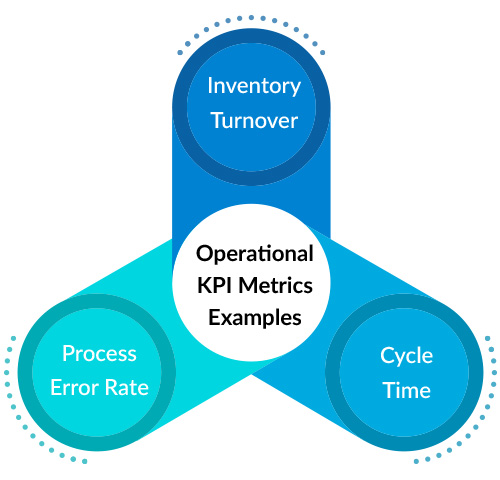
KPI examples of operational metrics include:
- Inventory Turnover: Tracks how often inventory is sold and replaced over a specific period.
- Cycle Time: Measures the time to complete a process or deliver a product.
- Process Error Rate: Measures the frequency of errors within an operation.
Operational efficiency and process optimization are critical goals of operational KPI metrics. Enriching operational KPIs with market data, such as demand forecasts or competitor benchmarks, ensures that internal processes align with external expectations.
Financial KPI Metrics
Financial metrics provide a snapshot of a company’s financial health, tracking profitability, liquidity, and cash flow. These KPIs are foundational for understanding how well a business generates revenue, controls costs, and manages financial resources.
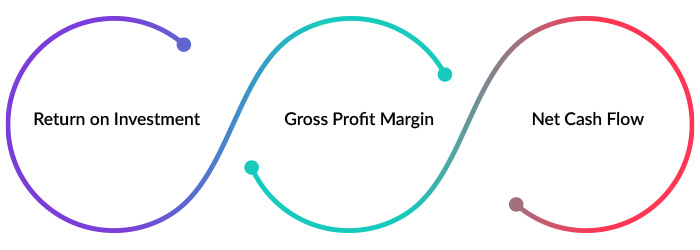
Some common examples of financial metrics include:
- Return on Investment (ROI): Tracks the profitability of an investment.
- Gross Profit Margin: Measures the percentage of revenue after accounting for the cost of goods sold.
- Net Cash Flow: Reflects the cash generated or used by the business during a specific period.
Enriching financial KPIs with industry benchmarks or economic indicators allows companies to compare their performance to the broader market and adjust strategies accordingly. This allows businesses to assess better how their financials stack up against competitors or market conditions.
Customer KPI Metrics
Customer metrics focus on measuring the satisfaction, loyalty, and engagement of a business’s customer base. These KPIs are vital for understanding how well a company meets customer needs, retains clients, and fosters long-term relationships.
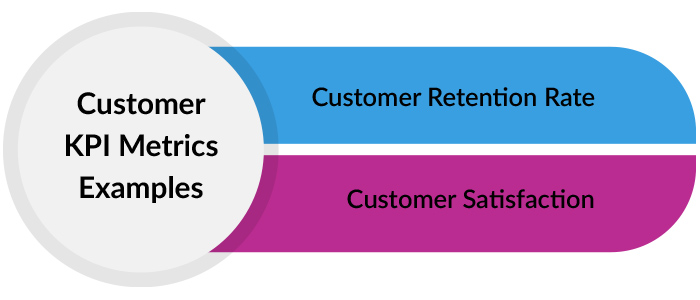
Common KPI examples of customer metrics include:
- Customer Retention Rate: Measures the percentage of customers a company retains over a specific period.
- Customer Satisfaction (CSAT): Gauges customers’ satisfaction with the company’s products or services.
Enriching customer KPIs involves integrating external data like market trends and competitor performance to gain a comprehensive view of how customers perceive the business about the industry as a whole.
Employee KPI Metrics
Employee metrics are critical for assessing the productivity, satisfaction, and engagement levels of a company’s employees. These KPIs provide insights into workforce efficiency, employee morale, and how well human capital is being managed to support organizational goals.
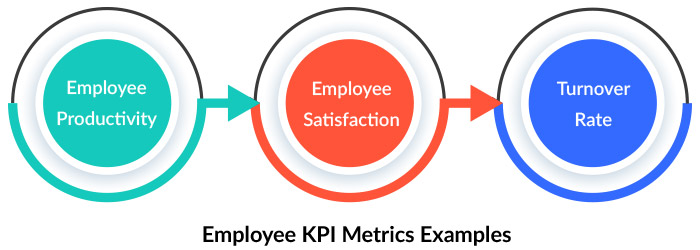
Some common KPI examples of employee metrics include:
- Employee Productivity: Measures the output per employee over a specific period.
- Employee Satisfaction: Gauges employee happiness and job satisfaction.
- Turnover Rate: Tracks the percentage of employees who leave the company over a given period.
Enriched employee KPIs incorporate benchmark data from similar industries or regions, helping businesses understand how their workforce compares in terms of engagement and productivity.
Risk KPI Metrics
Risk metrics, often expressed as Key Risk Indicators (KRIs), help organizations monitor potential operational and financial health threats. When integrated into KPIs, risk metrics provide early warning signs that enable businesses to take proactive steps to mitigate potential issues.

Some KPI examples of risk metrics include:
- Operational Risk Exposure: Tracks the probability and impact of risks related to operational disruptions.
- Credit Risk: Assesses the likelihood that customers or clients will default on their payments.
- Compliance Risk: Measures the risk of failing to meet regulatory or legal obligations.
Enriching risk metrics involves integrating internal risk data (such as risk incident reports or compliance breaches) with external factors like market conditions, regulatory changes, and economic forecasts.
Challenges in Implementing Enriched KPI Metrics
The journey to implementing enriched KPI metrics is not without its challenges. Mid-sized businesses face several roadblocks, ranging from data overload to resource constraints and even cultural resistance to data-driven decision-making. Understanding these challenges enables companies to better anticipate and overcome obstacles, ensuring KPIs are successfully integrated into their strategic framework.
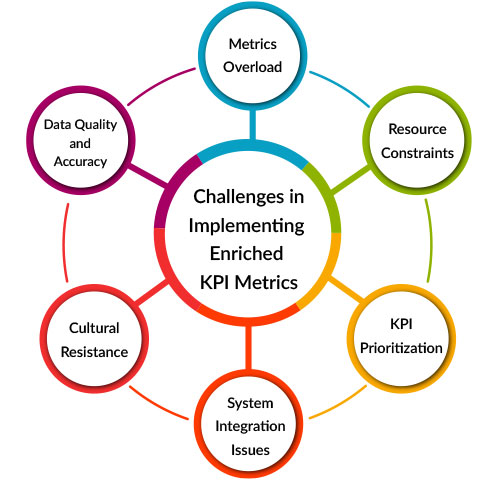
Metrics Overload
One of the most common challenges businesses face is metrics overload—tracking too many KPIs without a clear understanding of which ones truly drive performance. While measuring as much as possible is tempting, too many metrics can overwhelm teams and dilute focus. When everything is being measured, it becomes difficult to prioritize what’s truly important for the organization.
Resource Constraints
Implementing a comprehensive system for tracking and analyzing enriched KPI metrics often requires significant time and financial investment. Many mid-market businesses may struggle to allocate the necessary budget for the tools, technology, and expertise required to collect, analyze, and interpret enriched KPIs.
KPI Prioritization
Another challenge is determining the right balance between short-term and long-term KPIs. Some metrics provide immediate insights into the business’s current state, while others focus on long-term strategic goals. Focusing too heavily on short-term KPIs can cause businesses to lose sight of their long-term objectives, while overemphasizing long-term metrics may leave them blind to urgent operational issues.
System Integration Issues
A major technical challenge in implementing enriched KPIs is system integration. In many organizations, different departments use separate systems to manage their data CRM for sales, an ERP for operations, or a dedicated finance system for accounting. This siloed approach can create significant difficulties when aligning KPIs across the organization.
Cultural Resistance
A significant but often overlooked challenge is cultural resistance. Employees may resist the adoption of a data-driven culture for various reasons, such as fear of increased accountability, lack of familiarity with technology, or simply a preference for traditional decision-making approaches.
Data Quality and Accuracy
Finally, the success of any KPI initiative hinges on the quality and accuracy of the data being used. Poor data quality—whether due to incomplete, outdated, or inaccurate information—can result in KPIs that do not reflect the actual state of the business, leading to misguided decisions.
Best Practices for Enriched KPI Metrics Management
Implementing and managing enriched KPI metrics effectively is crucial for businesses aiming to unlock growth and improve performance. To achieve the full potential of enriched KPIs, mid-market companies must follow the best practices that align metrics with strategy, ensure continuous improvement, and facilitate data integrity. Some steps businesses can take include the following.
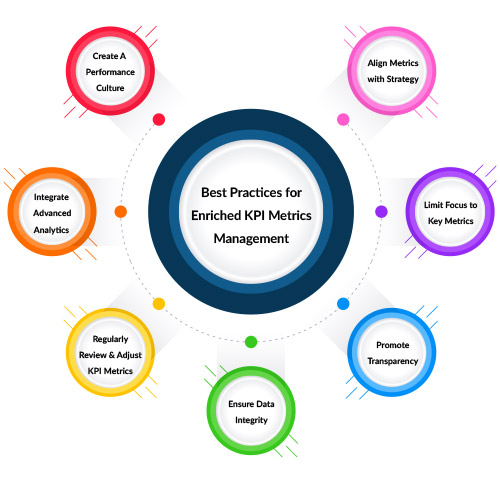
1. Align Metrics with Strategy
A fundamental principle of enriched KPI management is ensuring that KPIs are aligned with the company’s overall business strategy and goals. Each KPI should reflect a critical business area that needs to be measured to track progress toward specific goals. This ensures that KPIs are not just data points but powerful tools that help the company achieve its vision.
For example, if your business is focused on increasing market share, relevant metrics might include customer acquisition cost (CAC), sales growth rate, and brand awareness metrics. For a business aiming to improve operational efficiency, metrics like cycle time, inventory turnover, or process error rate would be more appropriate.
The key is to start with your business goals and work backward to identify which metrics will best measure progress toward these objectives. Each KPI should be tied to a specific goal and provide actionable insights that enable managers to adjust strategies as needed.
2. Limit Focus to Key Metrics
One of the biggest challenges in KPI management is ensuring that the organization focuses on the most relevant and impactful metrics. Tracking too many KPIs can lead to confusion, reduce the clarity of insights, and dilute efforts across the board. To avoid metrics overload, businesses should focus on a limited number of key metrics that provide the most value.
To avoid this, businesses should identify the metrics that truly drive performance and limit them to those that directly impact their business goals. Vanity metrics like social media followers or the number of downloads may look impressive, but they don’t necessarily reflect business success. Avoid them where possible.
By prioritizing quality over quantity, businesses can focus on a select group of enriched KPI metrics that provide real insights and avoid being bogged down by data that doesn’t serve their goals.
3. Promote Transparency
Transparency is essential when it comes to KPI management. Sharing KPI data across the organization encourages accountability, fosters trust, and enables all employees to understand how their actions contribute to the company’s overall performance.
One way to improve transparency is to provide employees at all levels with access to KPI dashboards to track performance in real-time. Management should hold regular meetings to discuss KPI metrics performance and ensure all departments understand how they contribute to organizational goals.
Mid-sized businesses should also involve departmental teams in setting their KPIs to create a sense of ownership and accountability.
4. Ensure Data Integrity
The accuracy and reliability of KPI metrics depend on the integrity of the data fed into them. Poor-quality data can lead to inaccurate KPIs, which in turn can result in flawed decision-making. Businesses must establish rigorous data management processes to ensure the data feeding into KPIs is consistent, accurate, and current.
Businesses must create a data governance framework that outlines data collection, storage, validation, and cleansing processes. Where possible, collecting and aggregating KPI data should be automated to reduce the risk of human error. Regular audits of data sources must be conducted to ensure that the information used for KPIs remains accurate and relevant.
By ensuring data integrity, businesses can trust the KPIs they use to guide strategic decisions, improving confidence in their metrics and performance outcomes.
5. Regularly Review and Adjust KPI Metrics
The effectiveness of enriched KPI metrics lies in their ability to evolve. As business environments, market conditions, and internal processes change, KPIs must be reviewed and adjusted to stay relevant.
Businesses can conduct formal reviews of KPIs on a quarterly or semi-annual basis to ensure they continue to reflect current business priorities. If some KPIs are consistently underperforming or no longer serve as accurate indicators of success, they should be replaced with more relevant metrics.
6. Integrate Advanced Analytics
As businesses increasingly turn to advanced analytics to enhance decision-making, enriched KPIs can be strengthened through AI, predictive modeling, and machine learning. Advanced analytical tools allow businesses to uncover trends, patterns, and insights that may not be immediately apparent through traditional KPI tracking.
For example, platforms like Lumify360 use an AI companion to make sense of correlations and patterns in data, which can provide deeper insights into performance. Similarly, implementing systems that automate report generation and visualization reduces manual effort and provides teams with real-time insights.
Integrating advanced analytics into KPI management can help businesses make more informed decisions, enabling them to anticipate changes and stay competitive in a rapidly evolving marketplace.
7. Create a Performance Culture
Ultimately, the effectiveness of enriched KPI metrics depends on the organizational culture in which they are implemented. For KPI metrics to drive meaningful improvements, businesses must foster a performance-driven culture where data and metrics are valued, understood, and actively used by all levels of the organization.
Ensure employees at all levels understand how to interpret and act on KPI metrics data. Provide ongoing training on analysis and decision-making to embed KPIs into the daily workflow. Incorporate KPI results into performance reviews, promotions, and reward systems to incentivize employees. Hold regular performance check-ins where departments and teams discuss their progress against KPIs and how to improve.
By creating a culture that values continuous improvement and relies on KPIs to drive business outcomes, businesses ensure that KPI metrics are used as a tool for growth and not just as a measurement of past performance.
How to Measure Enriched KPI Metrics
Measuring enriched KPI metrics allows businesses to gain actionable insights into their performance, track progress, and make informed decisions. Proper measurement ensures that the data collected reflects real-world operations, helping companies understand their strategies’ impact and adjust accordingly. Here are key aspects of measuring enriched KPIs effectively:
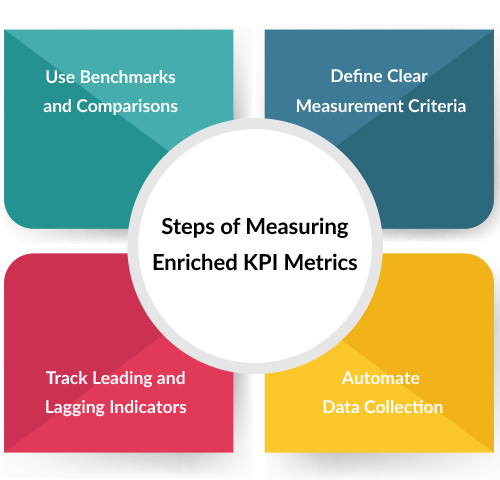
Steps of Measuring Enriched KPI Metrics
- Define Clear Measurement Criteria: Establishing clear, quantifiable criteria for each KPI metric is crucial. This involves breaking down each KPI metric into measurable components that align with business goals. For example, if an enriched KPI metric is customer satisfaction, the measurement criteria might involve survey scores, response times, and repeat business rates.
- Automate Data Collection: Relying on manual data collection for enriched KPI metrics can introduce errors and inconsistencies. Implementing automated data collection systems ensures that data is gathered consistently and accurately, reducing the risk of human error and freeing up valuable time for analysis.
- Use Benchmarks and Comparisons: To better understand how enriched KPI metrics reflect business performance, it is essential to compare the data against relevant industry benchmarks or historical data. This helps contextualize the data and reveals whether the company is underperforming, meeting, or exceeding expectations.
- Track Leading and Lagging Indicators: When measuring enriched KPIs, it’s essential to account for leading and lagging indicators. Leading indicators, such as expected customer demand, predict future performance, while lagging indicators, such as last quarter’s profit, measure past performance.
Tools for Tracking Metrics
Effective measurement of enriched KPI metrics requires advanced tools and technologies that allow real-time tracking, analytics, and reporting. Modern software enables businesses to move beyond traditional spreadsheets and into comprehensive, data-driven environments that enhance decision-making.
![]()
- KPI Dashboards are the most effective tools for tracking KPIs. KPI dashboards consolidate data into visual formats like graphs, charts, and tables, offering at-a-glance insights into performance across different business areas. Dashboards can be customized to display real-time or historical data, making them highly adaptable for business needs.
- AI Analytics Tools are revolutionizing the way businesses measure and track KPIs. These tools can uncover insights that traditional measurement methods may lack by leveraging AI and machine learning algorithms. For example, AI tools can identify errors, answer queries, and recommend actions based on data analysis.
- Integrated Business Intelligence (BI) Tools integrate data from various sources (CRM systems, financial software, HR tools, etc.) to provide a unified view of organizational performance. These platforms are crucial for tracking KPIs that depend on multiple data points from different departments.
- Data Warehousing Solutions provide a centralized repository to store and manage information. These solutions ensure data feeding into KPIs is accurate, up-to-date, and easily accessible. Historical data can be stored, making it easy to track trends and compare performance over time.
How to Interpret and Analyze Enriched KPI Metrics
The real value of enriched KPI metrics lies in how they are interpreted and analyzed. This involves taking the data generated by your KPIs and deriving actionable insights to improve business strategies, optimize operations, and predict future outcomes. You need to focus on proper data interpretation, trend analysis, and advanced analytical tools to get the most from your enriched KPI metrics.

How to Analyze and Interpret KPI Metrics
- Understanding Context and Benchmarks: KPI metrics don’t exist in a vacuum. To interpret them accurately, businesses must evaluate their performance in the context of industry benchmarks, historical trends, and organizational goals. This ensures that the analysis is not just about numbers but about how those numbers reflect business progress. KPIs must be measured against past business performance and industry-specific benchmarks to assess how the business is doing compared to competitors.
- Explore KPIs in Detail: Businesses must comprehensively review KPI metrics and drill down to specific data points to uncover root causes of performance. For example, if you notice a drop in revenue, further analysis of customer segments might reveal that high-value customers are leaving, pointing to an issue with product satisfaction or service quality.
- Identify Correlations Between Metrics: KPI metrics are often interrelated, and analyzing their relationship can reveal deeper insights into performance drivers. For example, KPI metrics related to employee engagement may have a direct impact on customer satisfaction and ultimately impact revenue growth KPI metrics.
- Establish Actionable Insights: Once metrics data is analyzed, the next step is to turn the findings into actionable insights that can improve business outcomes. This might involve tweaking a product offering, launching a new customer service initiative, or reallocating resources to underperforming areas.
Understanding Trends and Patterns
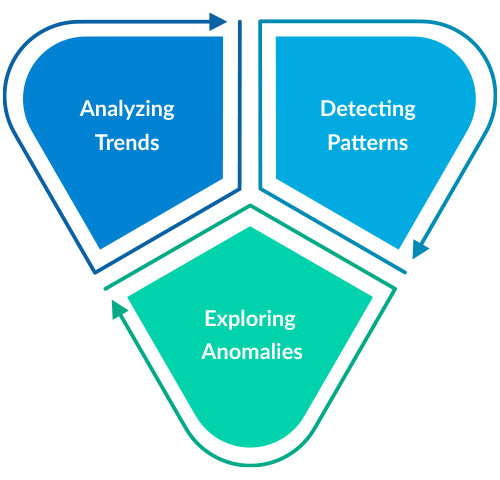
- Analyzing Trends: KPI metrics are most valuable when analyzed over time, as they reveal trends that can indicate the direction in which your business is headed. Trend analysis helps organizations identify patterns that might signal a need for strategy adjustments or confirm the success of a recent initiative. Regularly compare current KPI performance with historical data to identify long-term trends. For example, rising customer acquisition costs might suggest the need for a revamped marketing strategy.
- Detecting Patterns Analyzing KPI data often uncovers patterns that may not be immediately obvious but offer valuable insights into business performance. Recognizing patterns can help businesses anticipate potential risks or opportunities. For instance, if a company experiences a sudden surge in performance, analysis may reveal that it was due to a successful customer engagement campaign. Similarly, analyzing a consistent rise in customer dissatisfaction may indicate a risk of future churn if corrective actions are not taken.
- Exploring Anomalies: Anomalies are unexpected and rare deviations in KPI data. They can signal problems and opportunities, and businesses must investigate the root cause of anomalies. For example, if sales drop unexpectedly, it could be due to operational disruptions or a competitor launching a new product. By quickly identifying the root cause, businesses can take swift action to capitalize on opportunities and overcome challenges.
The Role of Advanced Analytics Technology (AI, Predictive Modeling)
Advanced analytics tools, such as AI and predictive modeling, can significantly enhance the analysis of enriched KPI metrics. These technologies go beyond traditional analysis by uncovering hidden insights, predicting future outcomes, and offering recommendations for strategic actions. For instance, AI can quickly sift through large volumes of KPI data to identify relevant patterns and relationships, saving time and improving accuracy.
Most new, advanced analytics platforms offer real-time data analysis capabilities, enabling mid-sized businesses to monitor KPIs continuously and respond to changes as they happen. Real-time analysis is especially valuable for fast-moving industries where timely decisions are critical. For example, if a sudden drop in website traffic is detected, immediate adjustments to a marketing campaign can be made to mitigate the impact.
Improving Business Performance with Enriched KPI Metrics
Data-driven enriched KPI metrics can significantly improve a business’s performance by providing actionable insights and advanced decision-making capabilities. Organizations can improve efficiency, productivity, profitability, and competitiveness by integrating enriched metrics into every business function. The key lies in effectively using enriched metrics to design strategies, monitor performance, and create a performance-driven culture.
How Enriched Metrics Drive Business Improvements
Enriched KPI metrics allow businesses to pinpoint inefficiencies and underperformance across various functions, enabling them to focus their improvement efforts where they matter most. Whether it’s optimizing operational workflows, improving customer satisfaction, or increasing employee productivity, enriched KPIs reveal where the business can gain the most traction.
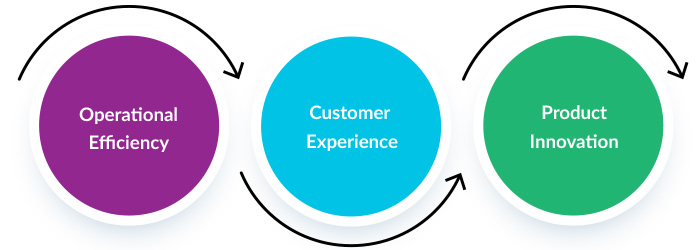
- Operational Efficiency: By analyzing operational metrics, businesses can uncover process bottlenecks or redundancies. For example, tracking metrics such as production cycle time and cost per unit can highlight areas where automation or better resource management can improve throughput and reduce costs.
- Customer Experience: Metrics like Customer Acquisition Cost (CAC) and Customer Satisfaction (CSAT) can illuminate the customer journey, helping businesses address pain points and improve retention rates.
- Product Innovation: Monitoring product-related KPIs like defect rates, time to market, and product development costs can help businesses refine their offerings, enhance quality, and speed up product launches, giving them a competitive edge.
How Enriched Metrics Improve Strategic Decision-Making
Enriched KPI metrics provide leaders with the data necessary to make strategic decisions confidently. Metrics-driven decision-making ensures that business strategies are aligned with real-time data, reducing guesswork and enabling better outcomes.
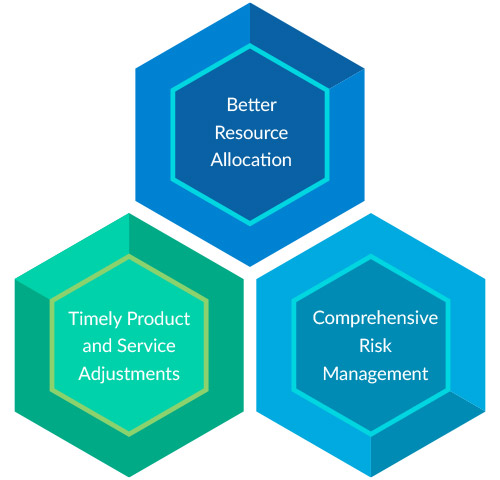
- Resource Allocation: When a company tracks KPIs across different business functions, allocating resources where they are needed the most is easier. For instance, if marketing KPIs reveal a high return on investment (ROI) from specific campaigns, leaders can shift more resources toward those strategies while reducing spending in lower-performing campaigns.
- Product and Service Adjustments: Enriched KPIs also affect product development and service enhancement decisions. By analyzing customer feedback and product usage data metrics, businesses can decide which features are popular and should be pursued or where improvements are needed, helping to drive innovation and customer satisfaction.
- Risk Management: Tracking risk-related KPIs allows businesses to identify emerging risks and decide on mitigation strategies quickly. For example, credit risk can be monitored as a metric, and business leaders can adjust lending strategies to avoid default risk.
How to Create a Performance-Driven Culture
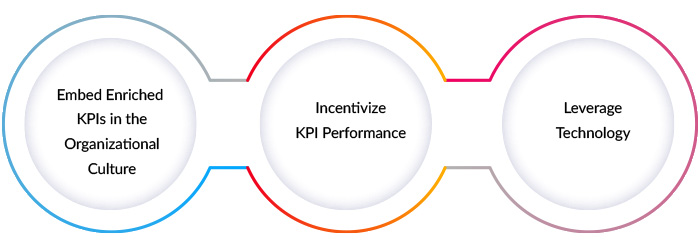
- Embedding Enriched KPIs in the Organizational Culture: Enriched KPI metrics must be integrated into the company’s culture to drive performance improvements. This means ensuring that all employees—from top management to frontline staff—understand the importance of KPIs and how they contribute to achieving the company’s strategic goals.
- Incentivizing KPI Performance: Aligning compensation and rewards with KPI performance is a powerful way to motivate employees to prioritize data-driven decision-making and continuous improvement. For example, sales teams might be incentivized based on KPIs such as revenue growth or customer acquisition, while operations teams might be rewarded for improvements in production efficiency.
- Leveraging Technology: Advanced analytics tools, like Lumify360, empower businesses to track KPIs seamlessly and make data more accessible to employees at all levels. When employees can easily visualize their performance metrics and see how their contributions impact the company’s broader goals, they are more likely to embrace a performance-driven mindset. Its KPI dashboard enables employees to monitor performance in real time, creating transparency and accountability. Technology facilitates team collaboration and data-sharing to make collective decisions and drive improvements.
Conclusion
Enriched KPI metrics can transform how mid-market businesses approach performance management, decision-making, and long-term growth. By integrating a robust, data-driven approach to KPI selection and monitoring, companies can unlock new insights, improve operational efficiency, and make more informed strategic decisions. In this guide, we’ve explored the importance of enriched KPIs, how they are categorized, the challenges in their implementation, and the best practices for managing them effectively. Here’s a recap of why selecting and tracking the right enriched KPIs is crucial for your business:
Recap of Key Points
- Enriched KPIs go beyond basic metrics, incorporating deeper, multidimensional insights that help businesses understand what is happening and why. By combining internal and external data, enriched KPIs provide a comprehensive view of business performance.
- KPIs aligned with business goals provide the framework for more effective decision-making. Whether improving customer satisfaction, streamlining operations, or boosting profitability, enriched KPIs enable businesses to track progress and adjust strategies, driving sustainable performance improvements.
- Implementing enriched KPI has challenges, including metrics overload, resource constraints, or resistance to change. However, with the right tools, such as Lumify360, businesses can streamline KPI management, integrate advanced analytics, and ensure data integrity.
- A critical aspect of enriched KPIs is continuous monitoring and adjustment. As markets evolve and business goals shift, so must your KPIs. Regular reviews ensure that your metrics remain relevant and align with strategies, allowing businesses to stay agile and responsive.
- Enriched KPI metrics give businesses the insights to drive long-term growth. From understanding trends and patterns to identifying potential risks, enriched KPI metrics serve as a roadmap for future success, allowing businesses to improve performance and position themselves for sustained growth in an increasingly competitive landscape.
- Enriched KPIs also foster a performance-driven culture where data is at the heart of every decision. This culture encourages transparency, accountability, and continuous improvement, creating a dynamic environment where all employees are aligned with the company’s strategic objectives
Take Action: Explore Lumify360
The Lumify360 platform enables businesses to manage enriched KPI metrics, integrate advanced analytics, and make data-driven decisions that drive growth.
Take the next step in unlocking growth and predicting performance by requesting a demo of Lumify360, consulting with our experts, or downloading our other KPI e-guides to explore the key features of the platform. Together, we can help you turn enriched KPI metrics into actionable insights that lead to measurable success.
